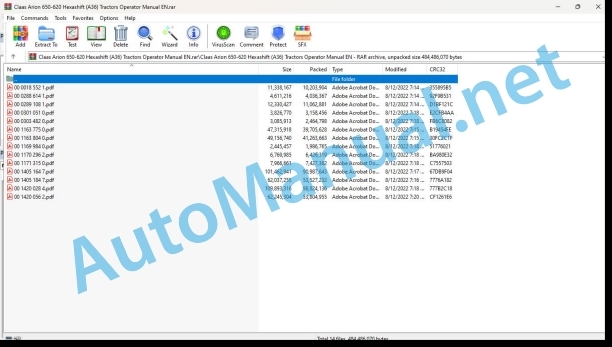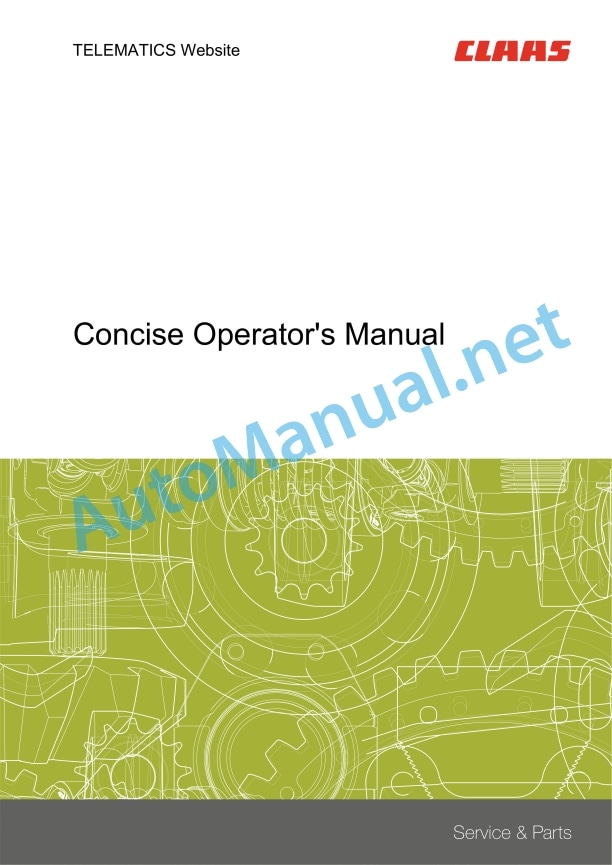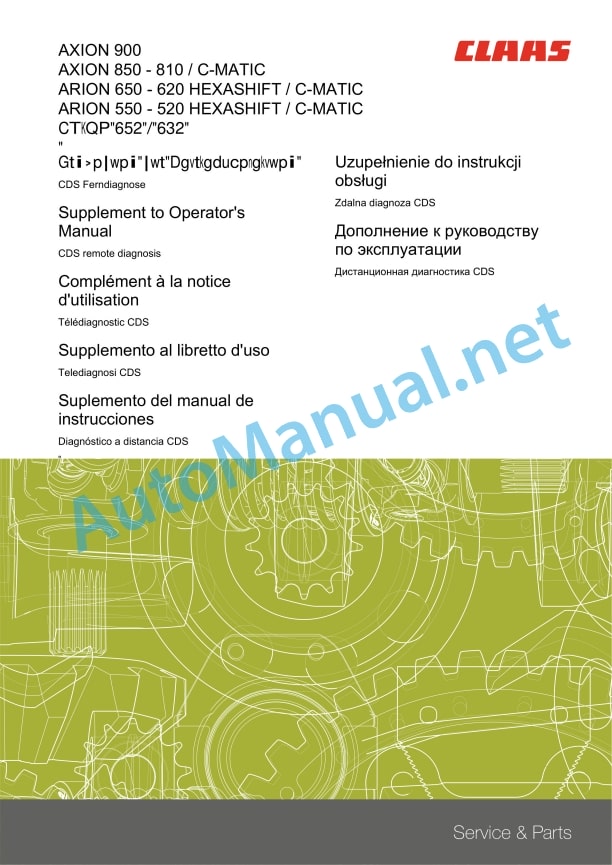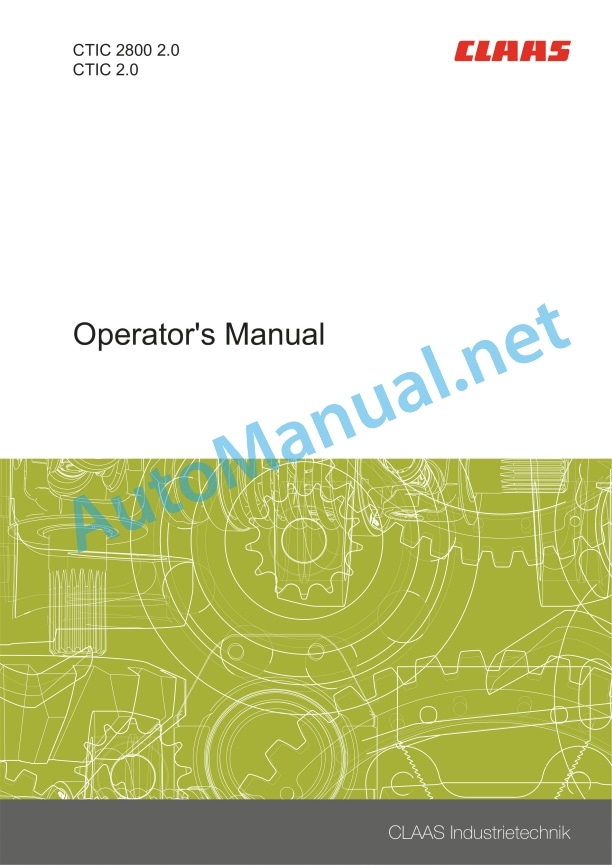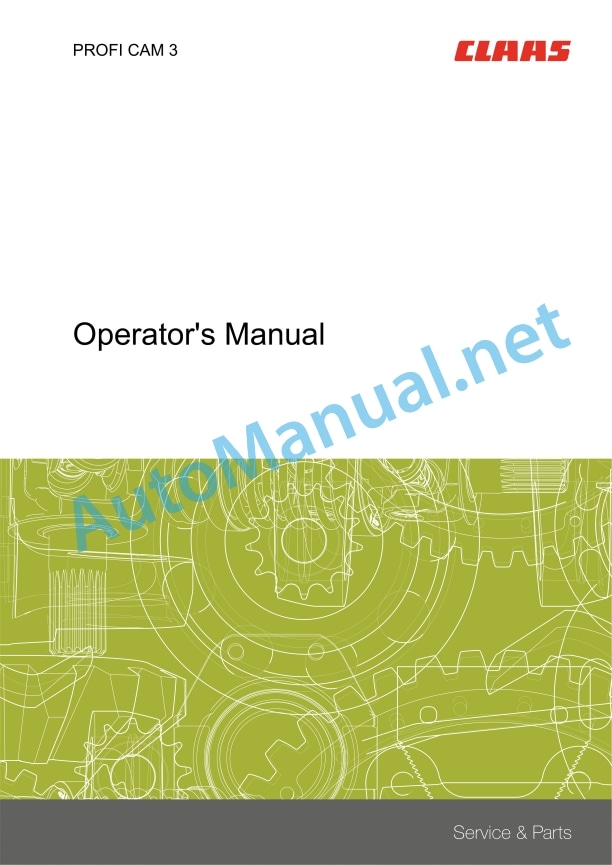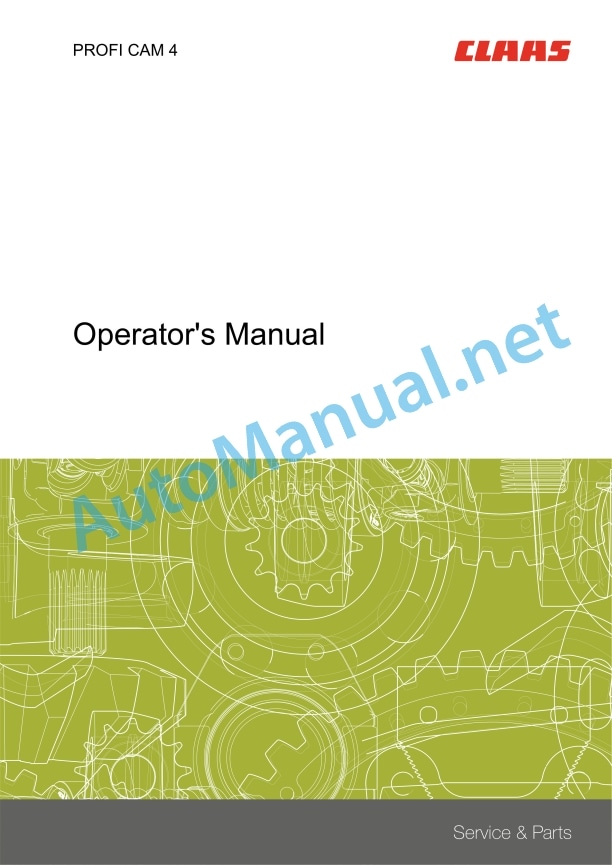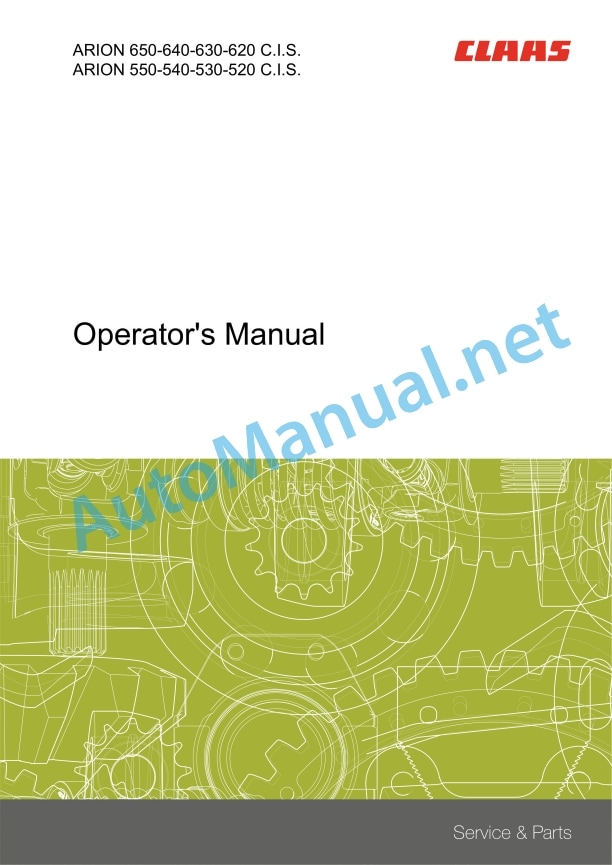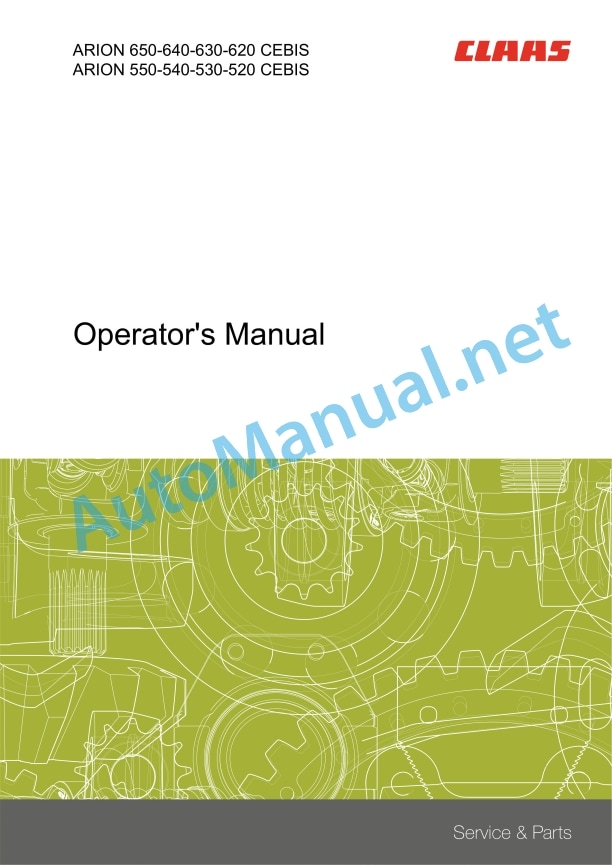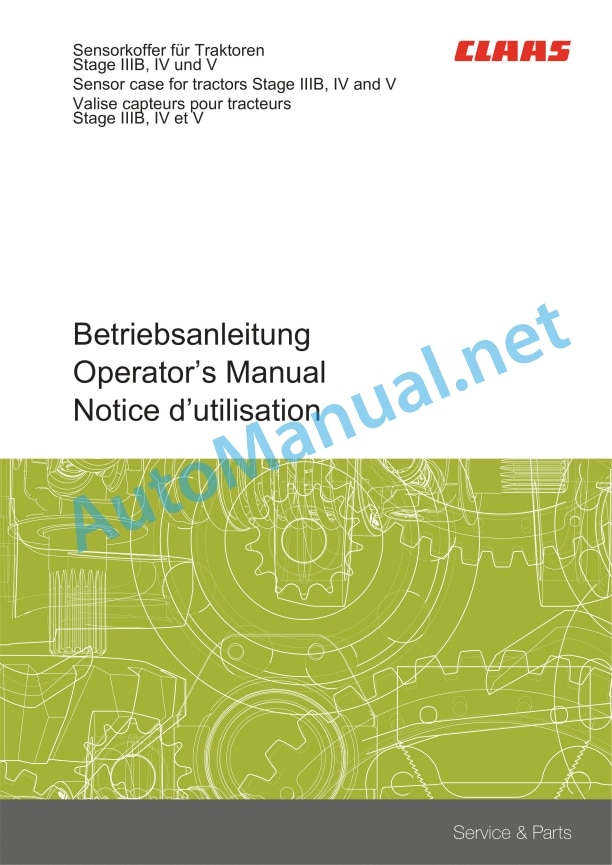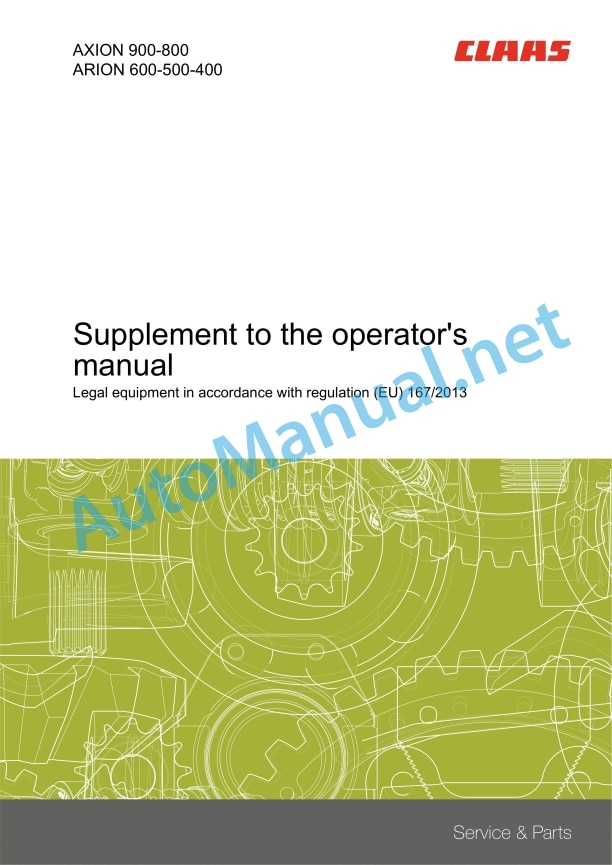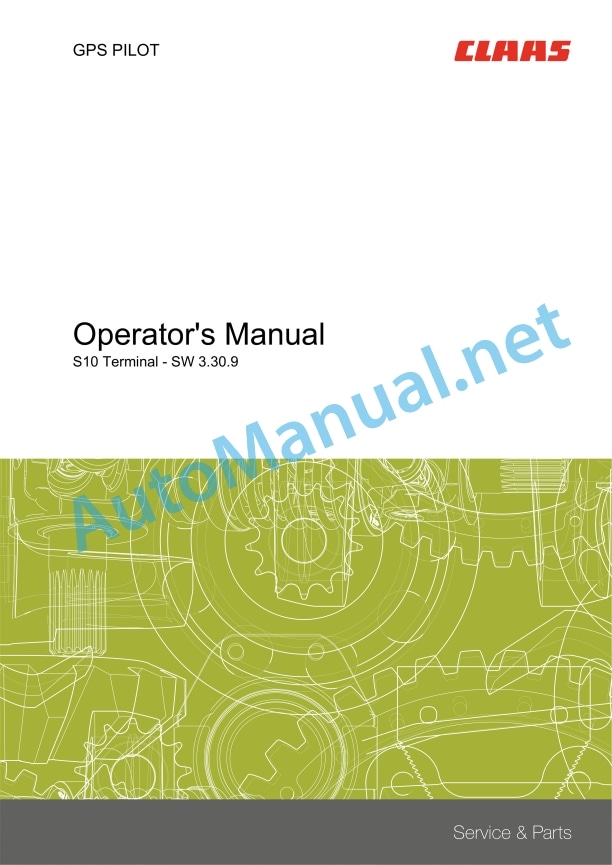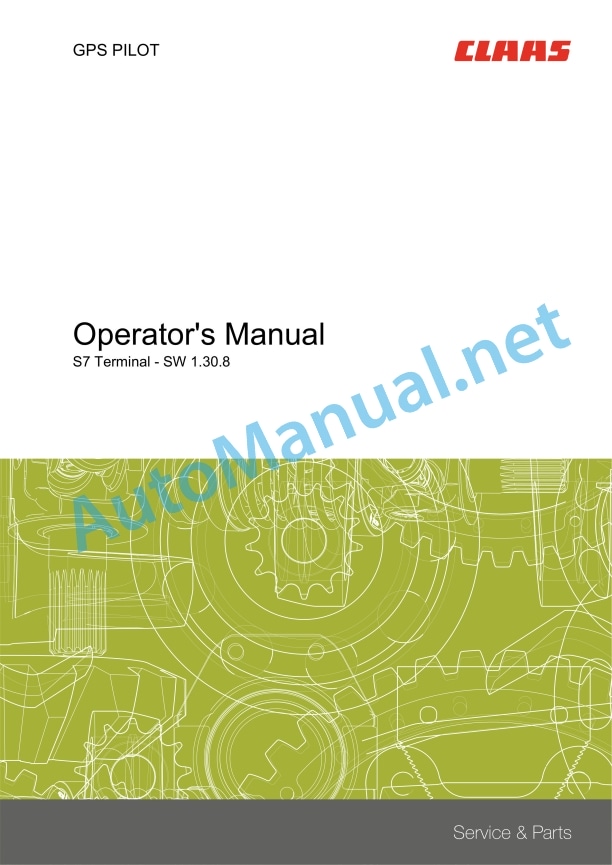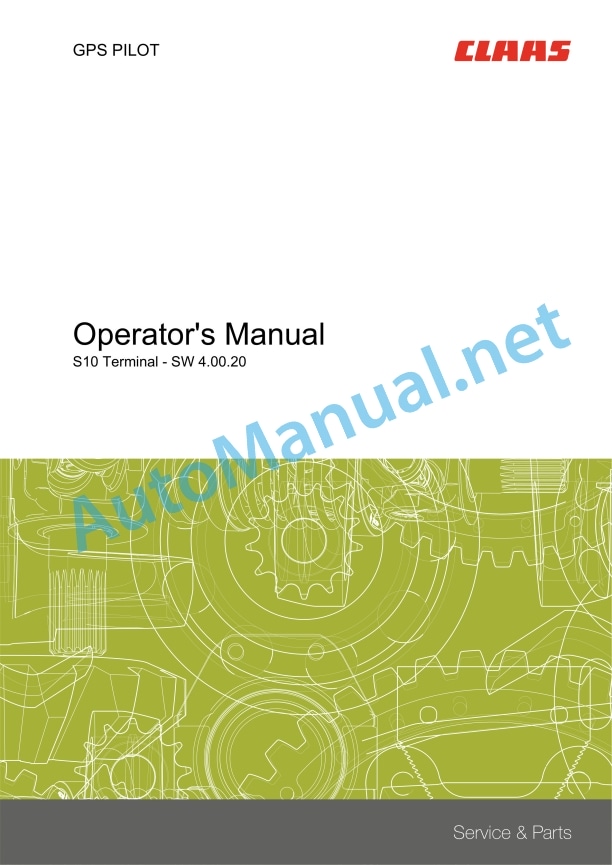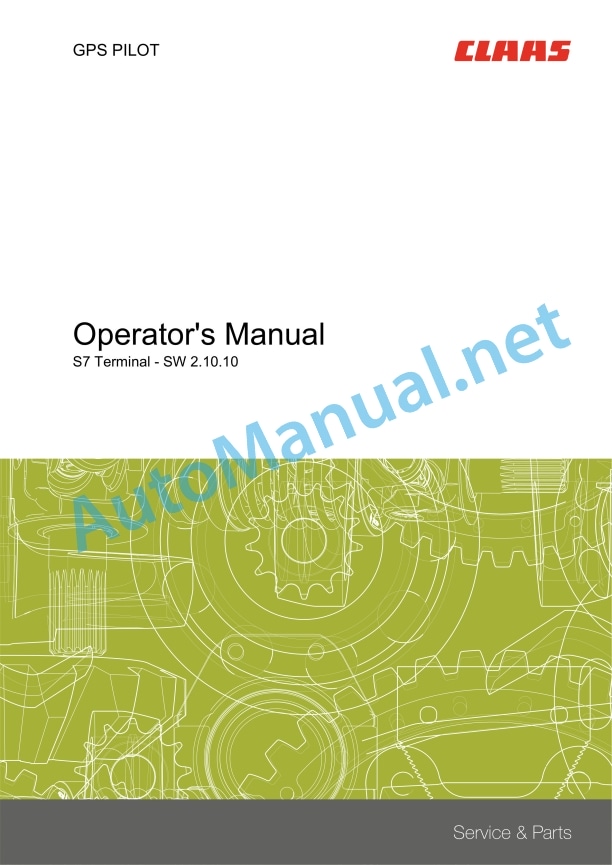Claas Arion 650-620 Hexashift (A36) Tractors Operator Manual EN
$50.00
- Model: Arion 650-620 Hexashift (A36) Tractors
- Type Of Manual: Operator Manual
- Language: EN
- Format: PDF(s)
- Size: 405 MB
File List:
00 0018 552 1.pdf
00 0288 614 1.pdf
00 0289 108 1.pdf
00 0301 051 0.pdf
00 0303 482 0.pdf
00 1163 775 0.pdf
00 1163 804 0.pdf
00 1169 984 0.pdf
00 1170 296 2.pdf
00 1171 315 0.pdf
00 1405 164 7.pdf
00 1405 184 7.pdf
00 1420 028 4.pdf
00 1420 056 2.pdf
00 0018 552 1.pdf:
TELEMATICS Website
Table of contents
1 About this Concise Operator’s Manual
1.1 Notes on the manual
1.1.1 Validity of manual
1.1.2 Notes regarding the Concise Operator’s Manual
1.1.3 Notes on warranty
2 Safety
2.1 Intended use
2.1.1 Proper use
3 Product description
3.1 Overview and method of operation
3.1.1 TELEMATICS product variants
3.1.2 TONI (TELEMATICS on implements)
3.1.3 Fleet View
3.1.4 TELEMATICS basic
3.1.5 TELEMATICS advanced
3.1.6 TELEMATICS professional
3.1.7 TELEMATICS app
4 Operating and control elements
4.1 TELEMATICS overview
4.1.1 Illustration conventions of buttons and navigation elements
4.1.2 Symbols and colours
4.2 Menu structure
4.2.1 Start screen
4.2.2 TELEMATICS website site map
4.2.3 Main menu overview
4.2.4
4.2.5
4.2.6
00 0289 108 1.pdf:
CTIC 2800 2.0CTIC 2.0
Table of contents
1 Introduction
1.1 General information
1.1.1 Validity of manual
1.1.2 Information about this Operator’s Manual
1.1.3 Symbols and notes
1.1.4 Optional equipment
1.1.5 Maintenance information
1.1.6 Warranty information
1.1.7 Qualified specialist workshop
1.1.8 Spare parts and technical questions
1.2 Intended use
1.2.1 Intended use
1.2.2 Reasonably foreseeable misuse
2 Safety
2.1 Identifying warnings
2.1.1 Hazard signs
2.1.2 Signal word
2.2 Safety rules
2.2.1 Importance of Operator’s Manual
2.2.2 Optional equipment and spare parts
2.2.3 Danger due to damage to the tyre pressure control system
2.2.4 Technical condition
2.2.5 Complying with technical limit values
2.2.6 Keeping protective devices functional
2.2.7 Personal protective equipment
2.2.8 Dangers when driving on the road and on the field
2.2.9 Environmental protection and disposal
2.2.10 Noise can damage your health
2.2.11 Pressurised fluids
2.2.12 Compressed air
2.2.13 Hot surfaces
2.2.14 Maintenance work and repair work
2.2.15 Welding work prohibited
3 Product description
3.1 Package list
3.1.1 Delivery state
3.2 Overview and method of operation
3.2.1 Tyre pressure control system
3.2.2 Tyre pressure control system
3.3 Safety devices
3.3.1 Mechanical and electronic safety features
Pressure limitation
System behaviour when an air line is torn off
Manual operation
3.4 Identification plates and identification numbers
3.4.1 Identification plate of tyre pressure control system
4 Operating and display elements
4.1 Monitor
4.1.1 Overview of operating screen
4.2
4.2.1
4.2.2
4.3
4.3.1
4.3.2
4.3.3
4.3.4
4.4
4.4.1
5 Technical specifications
5.1 Tyre pressure control system
5.1.1 Properties
5.1.2 Lubricants
6 Handling
6.1 Transport and storage
6.1.1 Transport
Compressor
6.1.2 Storage
7 Preparing the product
7.1 Putting into operation
7.1.1 Carry out prior to operation
Installing the tyre pressure control system
Workplace description
8 Operation
8.1 Tyre pressure control system
8.1.1 Observe prior to operating the system
8.1.2 Parking position
Removing the rotary transmission leadthrough cover
Removing the rotary transmission leadthrough cover
Moving the hose packages of front wheels to the parking position
Moving the hose package of the rear right wheel to the parking position
Moving the hose package of the rear left wheel to the parking position
Installing the cover on the rotary transmission leadthrough
Installing the cover on the rotary transmission leadthrough
Removing the rotary transmission leadthroughs
8.1.3 Parking position
Removing the rotary transmission leadthrough cover
Removing the rotary transmission leadthrough cover
Moving the hose packages of front wheels to the parking position
Moving the hose package of the rear right wheel to the parking position
Moving the hose package of the rear left wheel to the parking position
Installing the cover on the rotary transmission leadthrough
Installing the cover on the rotary transmission leadthrough
Removing the rotary transmission leadthroughs
8.1.4 Working position
Installing the rotary couplings
Moving the hose packages of front wheels to the working position
Moving the hose package of the rear right wheel to the working position
Moving the hose package of the rear left wheel to the working position
Installing the cover on the rotary transmission leadthrough
Installing the cover on the rotary transmission leadthrough
8.1.5 Working position
Installing the rotary couplings
Moving the hose packages of front wheels to the working position
Moving the hose package of the rear right wheel to the working position
Moving the hose package of the rear left wheel to the working position
Installing the cover on the rotary transmission leadthrough
Installing the cover on the rotary transmission leadthrough
8.1.6 Determining the wheel loads
Fundamentals for determining wheel loads
Determining the wheel load on the front axle
Determining the wheel load on the rear axle
Determining the wheel load of the hitched implement
Example of how to calculate the wheel loads
8.1.7 Activating the tyre pressure control system
8.1.8 Deactivating the tyre pressure control system
8.1.9 Creating a profile
Entering the profile name
Setting the tyre pressure values for the towing vehicle
Enabling the trailer
Trailer priority circuit
Setting the tyre pressure values for the trailer
Selecting the tyre size
8.1.10 Changing the profile
8.1.11 Deleting the profile
8.1.12 Activating the profile
Operating the profile in
Changing set values in
Operating the profile in
9 Faults and remedies
9.1 Tyre pressure control system
9.1.1 Overview of possible problems with the tyre pressure control system
10 Maintenance
10.1 Maintenance interval overview
10.1.1 Operating hours
10.1.2 Every 10 operating hours or daily
10.1.3 Every 600 operating hours
10.1.4 Every 1200 operating hours or annually
10.1.5 Maintenance work every 2400 operating hours
10.2 Tyre pressure control system
10.2.1 Cleaning and preserving the tyre pressure control system
10.2.2 Checking and cleaning the compressor air filter
Checking the air filter
Cleaning the air filter
10.2.3 Changing the air filter element
10.2.4 Cap
Removing
Installing
10.2.5 Checking the compressor oil level
10.2.6 Checking the compressor oil level
10.2.7 Changing the compressor oil and oil filter
Changing the oil filter
Topping up oil
10.2.8 Replacing the compressor oil separator
11 Putting out of operation and disposal
11.1 General information
11.1.1 Putting out of operation and disposal
00 0301 051 0.pdf:
PROFI CAM 3
Table of contents
1 Introduction
1.1 Notes on the manual
1.1.1 Validity of manual
1.1.2 Information about this Operator’s Manual
1.1.3 Symbols and notes
1.1.4 Optional equipment
1.1.5 Qualified specialist workshop
1.1.6 Maintenance information
1.1.7 Warranty notes
1.1.8 Spare parts and technical questions
1.2 Intended use
1.2.1 Intended use
1.2.2 Reasonably foreseeable misuse
2 Safety
2.1 Identifying warnings
2.1.1 Hazard signs
2.1.2 Signal word
2.2 Safety rules
2.2.1 Meaning of Operator’s Manual
2.2.2 Observing safety decals and warnings
2.2.3 Optional equipment and spare parts
3 Product description
3.1 Overview and method of operation
3.1.1 How the PROFI CAM works
3.2 Identification plates and identification number
3.2.1 Position of identification plates
3.2.2 Explanation of PROFI CAM identification plate
3.3 Information on the product
3.3.1 CE marking
4 Operating and control elements
4.1 Camera system
4.1.1 Camera system monitor
4.2 Menu structure
4.2.1 Main menu
4.2.2
4.2.3
4.2.4
4.2.5
4.2.6
5 Technical specifications
5.1 PROFI CAM
5.1.1 Monitor
5.1.2 Camera
5.1.3 Switch box
5.1.4 Degree of protection against foreign bodies and water
6 Preparing the product
6.1 Shutting down and securing the machine
6.1.1 Switching off and securing the machine
6.2 Prior to operation
6.2.1 Carry out prior to operation
6.2.2 Installing the sun protection
6.2.3 Aligning the camera
6.2.4 Connecting the camera electrics
7 Operation
7.1 Monitor
7.1.1 Switching on the monitor
7.1.2 Calling up the menu
7.1.3 Setting a menu item
7.1.4 Setting the image orientation
7.1.5 Setting automatic screen darkening
7.1.6 Image mirroring
7.1.7 Setting the trigger view
7.1.8 Setting the follow-up time for trigger view
7.1.9 Setting the display mode
7.1.10 Activating/deactivating a display mode
8 Faults and remedies
8.1 Electrical and electronic system
8.1.1 Overview of problems on PROFI CAM camera system
8.1.2 Replacing the switch box fuse
9 Maintenance
9.1 Maintenance intervals
9.1.1 Every 10 operating hours or daily
9.2 Camera system
9.2.1 Checking the camera system for dirt
9.2.2 Cleaning the camera
9.2.3 Cleaning the switch box
9.2.4 Cleaning the monitor
10 Placing out of operation and disposal
10.1 General Information
10.1.1 Putting out of operation and disposal
11 Technical terms and abbreviations
11.1 Abbreviations
11.1.1 Units
11.1.2 Abbreviations
11.1.3 Technical terms
00 0303 482 0.pdf:
PROFI CAM 4
Table of contents
1 Introduction
1.1 Notes on the manual
1.1.1 Validity of manual
1.1.2 Information about this Operator’s Manual
1.1.3 Symbols and notes
1.1.4 Optional equipment
1.1.5 Qualified specialist workshop
1.1.6 Maintenance information
1.1.7 Notes on warranty
1.1.8 Spare parts and technical questions
1.2 Intended use
1.2.1 Intended use
1.2.2 Reasonably foreseeable misuse
2 Safety
2.1 Identifying warnings
2.1.1 Hazard signs
2.1.2 Signal word
2.2 Safety rules
2.2.1 Meaning of Operator’s Manual
2.2.2 Structural changes
2.2.3 Optional equipment and spare parts
2.2.4 Operation only following proper putting into operation
2.2.5 Technical status
2.2.6 Respecting technical limit values
Respecting technical limit values
2.2.7 Hazards when driving on roads and fields
3 Product description
3.1 Overview and method of operation
3.1.1 How the PROFI CAM works
3.2 Identification plates and identification number
3.2.1 Identification plates
3.3 Information on the product
3.3.1 CE marking
4 Operating and display elements
4.1 Camera system
4.1.1 Camera system monitor
4.1.2 CEBIS
4.2 Menu structure
4.2.1 Main menu
4.2.2
4.2.3
4.2.4
4.2.5
4.2.6
5 Technical specifications
5.1 PROFI CAM
5.1.1 Monitor
5.1.2 Camera
5.1.3 Switch box
6 Preparing the product
6.1 Switching off and securing the machine
6.1.1 Switching off and securing the machine
6.2 Prior to putting into operation
6.2.1 Carry out prior to operation
6.2.2 Installing the sun protection
6.2.3 Aligning the camera
7 Operation
7.1 Monitor
7.1.1 Switching on the monitor
7.1.2 Calling up the menu
7.1.3 Setting a menu item
7.1.4 Setting the image orientation
7.1.5 Setting automatic screen darkening
7.1.6 Image mirroring
7.1.7 Setting the trigger view
7.1.8 Setting the follow-up time for trigger view
7.1.9 Setting the display mode
7.1.10 Activating/deactivating a display mode
8 Faults and remedies
8.1 Electric and electronic system
8.1.1 Overview of problems on PROFI CAM camera system
9 Maintenance
9.1 Maintenance intervals
9.1.1 Every 10 operating hours or daily
9.2 Camera system
9.2.1 Checking the camera system for dirt
9.2.2 Cleaning the camera
9.2.3 Cleaning the switch box
9.2.4 Cleaning the monitor
10 Putting out of operation and disposal
10.1 General information
10.1.1 Putting out of operation and disposal
11 Technical terms and abbreviations
11.1 Abbreviations
11.1.1 Units
11.1.2 Abbreviations
11.1.3 Technical terms
00 1163 775 0.pdf:
ARION 650-640-630-620 C.I.S.ARION 550-540-530-520 C.I.S.
Table of contents
1 To this Operator’s Manual
1.1 Notes on the manual
1.1.1 Using the operator’s manual
Important information concerning this operator’s manual
Structure based on tractor subassemblies
Search and find
Direction indications
Specific terminology
Optional and additional equipment
1.1.2 Symbols and instructions
Text and illustrations
Highlighting dangers and warnings
1.1.3 Validity of the operator’s manual
1.1.4 Technical information
2 Safety
2.1 Safety rules
2.1.1 Appropriate use
2.1.2 Inappropriate use
2.1.3 European regulation
2.1.4 Safety and accident prevention instructions
2.1.5 Driving the tractor
2.1.6 Checking the condition of the tractor
2.1.7 Climbing into the cab and out of the tractor
Climbing into the tractor
Climbing out of the tractor
2.1.8 Passenger seat
2.1.9 Cab
Safety structure of the cab
Polluted environment
Cab category
Category 2 (protection against dust)
Category 3 (protection against dust and aerosols)
2.1.10 Precautions to be taken before starting up
2.1.11 Hitching implements
2.1.12 Adjusting and maintenance work
Special notes on mounting the tractor on axle stands
2.1.13 Using the front/rear power take-off
2.1.14 Fuel
2.1.15 Engine coolant
2.1.16 Air conditioning
2.1.17 Electrical system
2.1.18 Applications with front loaders
2.1.19 Forest applications
2.1.20 Stationary working
2.1.21 Implements operating at great depth
2.1.22 Twin wheels
2.2 Safety decals on the tractor
2.2.1 General advice regarding the safety markings
2.2.2 Warning symbols
2.3 Safety devices
2.3.1 Wheel chock location
2.3.2 First aid kit holder
3 Tractor description
3.1 Overview
3.1.1 Front right-hand view
3.1.2 Rear left-hand view
3.2 Identification plates and vehicle identification number
3.2.1 Tractor identification plate
Tractor identification number
Tractor regulation type
Tractor serial number
3.2.2 Tractor power label
3.2.3 Engine identification plate
Engine identification plate
Option codes label
Pollution control label
Emission control labels
3.2.4 Gearbox identification plate
3.2.5 Front axle identification plate
3.2.6 Pick-up hitch identification plate
3.2.7 Ladder hitch identification plate
3.2.8 Front power take-off identification plate
3.2.9 Cab identification plate
Situation 1
Situation 2
3.2.10 Additional cab identification plate
3.3 Information on the tractor
3.3.1 Electrical and electronic system
Primary accessories board
77 0007 746 3
Engine computer
00 2185 113 0
3.3.2 Tightening the wheels
4 Operating and display elements
4.1 Cab and operator’s platform
4.1.1 Multifunction armrest
4.1.2 Cab top
4.1.3 Right-hand cab pillar and right-hand console
4.1.4 Dashboard
4.1.5 C.I.S. terminal
4.1.6 Instrument panel
4.1.7 Main display
4.1.8 Transmission display panel
4.1.9 Manual air conditioning
4.1.10 Automatic air conditioning
4.1.11 Control panel for work lights and warning beacon
4.1.12 Driving position control levers
Indicator lights and horn
Screen wipers and washers
4.1.13 Right-hand console sockets
4.2 Hydraulic system
4.2.1 Hydraulic controls
4.3 Electrical and electronic system
4.3.1 External controls
Rear external controls
Front external controls
4.3.2 External electrical sockets
Rear external electrical sockets
Front external electrical sockets
4.4 C.I.S. display on the instrument panel
4.4.1 Introduction to the C.I.S. terminal
4.4.2 C.I.S. menu structure
4.4.3 Hydraulics
4.4.4 On board computer
4.4.5 Transmission
4.4.6 Consumption
4.4.7 Maintenance
4.4.8 Configuration
4.5 C.I.S. terminal on the front right cab post
4.5.1 Introduction to the C.I.S. terminal
4.5.2 Overview of the C.I.S. terminal
4.5.3 Work window 1
Electrohydraulic control valves window
Rear power take-off window
Rear linkage window
Window displaying the key assignments
4.5.4 Work window 2
4.5.5 C.I.S. menu structure
4.5.6 Engine/Transmission
4.5.7 Hydraulic
4.5.8 On board computer
4.5.9 CSM CLAAS Sequence Management
5 Technical specifications
5.1 ARION 650 – 520
5.1.1 Dimensions
5.1.2 Weight
5.1.3 Engine
5.1.4 Gearbox
5.1.5 Ground speeds
Standard range
Creeper range
Super-creeper range
5.1.6 Rear axle
5.1.7 Front axle
Suspended front axle
Rigid front axle
5.1.8 ARION 650-640: Table of front tracks
ARION 650-640: Rim with fixed wheel disc on rigid front axle
ARION 650-640: Rim with fixed wheel disc on suspended front axle equipped with brakes
ARION 650-640: Rim with variable wheel disc on rigid front axle
ARION 650-640: Rim with connector bars on rigid front axle
ARION 650-640: Rim with variable wheel disc on suspended front axle equipped with brakes
ARION 650-640: Rim with connector bars on suspended front axle equipped with brakes
5.1.9 ARION 650-640: Table of rear tracks
ARION 650-640: Rim with variable wheel disc on flanged axles
ARION 650-640: Rim with fixed wheel disc on flanged axles
ARION 650-640: Rim with fixed wheel disc on 2.5 and 3 m smooth shafts
5.1.10 ARION 630-620: Table of front tracks
ARION 630-620: Rim with fixed wheel disc on rigid front axle
ARION 630-620: Rim with fixed wheel disc on suspended front axle
ARION 630-620: Rim with fixed wheel disc on suspended front axle equipped with brakes
ARION 630-620: Rim with variable wheel disc on rigid front axle
ARION 630-620: Rim with connector bars on rigid front axle
ARION 630-620: Rim with variable wheel disc on suspended front axle
ARION 630-620: Rim with connector bars on suspended front axle
ARION 630-620: Rim with variable wheel disc on suspended front axle equipped with brakes
ARION 630-620: Rim with connector bars on suspended front axle equipped with brakes
5.1.11 ARION 630: Table of rear tracks
ARION 630: Rim with variable wheel disc on flanged axles
ARION 630: Rim with fixed wheel disc on flanged axles
ARION 630: Rim with fixed wheel disc on 2.5 and 3 m smooth shafts
5.1.12 ARION 620: Table of rear tracks (rear axle GPA 23)
ARION 620: Rim with variable wheel disc on flanged axles
ARION 620: Rim with fixed wheel disc on flanged axles
5.1.13 ARION 550-540: Table of front tracks
ARION 550-540: Rim with fixed wheel disc on rigid front axle
ARION 550-540: Rim with fixed wheel disc on suspended front axle
ARION 550-540: Rim with fixed wheel disc on suspended front axle equipped with brakes
ARION 550-540: Rim with variable wheel disc on rigid front axle
ARION 550-540: Rim with connector bars on rigid front axle
ARION 550-540: Rim with variable wheel disc on suspended front axle
ARION 550-540: Rim with connector bars on suspended front axle
ARION 550-540: Rim with variable wheel disc on suspended front axle equipped with brakes
ARION 550-540: Rim with connector bars on suspended front axle equipped with brakes
5.1.14 ARION 550 – 540: Table of rear tracks (rear axle GPA 23)
ARION 550 – 540: Rim with variable wheel disc on flanged axles
ARION 550 – 540: Rim with fixed wheel disc on flanged axles
ARION 550: Rim with fixed wheel disc on 2.5 and 3 m smooth shafts
5.1.15 ARION 540 – 530: Table of rear tracks (rear axle GPA 22+)
ARION 540 – 530: Rim with variable wheel disc on flanged axles
ARION 540 – 530: Rim with fixed wheel disc on flanged axles
5.1.16 ARION 530 – 520: Table of front tracks
ARION 530 – 520: Rim with fixed wheel disc on rigid front axle
ARION 530 – 520: Rim with fixed wheel disc on suspended front axle
ARION 530 – 520: Rim with fixed wheel disc on suspended front axle equipped with brakes
ARION 530 – 520: Rim with variable wheel disc on rigid front axle
ARION 530 – 520: Rim with variable wheel disc on suspended front axle
ARION 530 – 520: Rim with variable wheel disc on suspended front axle equipped with brakes
5.1.17 ARION 530 – 520: Table of rear tracks (rear axle GPA 22)
ARION 530 – 520: Rim with variable wheel disc on flanged axles
ARION 530 – 520: Rim with fixed wheel disc on flanged axles
5.1.18 Tyre combinations
5.1.19 Brakes
5.1.20 Steering
5.1.21 Rear linkage
5.1.22 Front linkage
5.1.23 Rear hitches
Ladder hitch
Hitching
Pick-up hitch
5.1.24 Rear power take-off
5.1.25 Front power take-off
5.1.26 Main hydraulic circuit (LS 110 l/min)
5.1.27 Electrical circuit
5.1.28 Cab characteristics
Noise level heard by the driver (according to European Directive 2009/76)
Noise level heard by a passer-by (according to European Directive 2009/63 Annex VI)
Transmission version: 40 km/h or 40 km/h ECO
Transmission version: 50 km/h
5.1.29 Seat vibration level
5.1.30 Ballast
5.1.31 Maximum authorised tow weights
5.1.32 Load capacities
5.1.33 Lubricants/Hydraulic oil
5.1.34 Engine coolant
5.1.35 Air conditioning refrigerant
6 Tractor preparation
6.1 Engine
6.1.1 Fuel
Quality requirement
Special notes on biofuels
Handling fuel
6.1.2 Topping up the fuel
6.1.3 Cold starting the engine / Engine coolant heater
6.2 Frame
6.2.1 Adjusting the rear axle track
Flanged shafts
Smooth shafts
6.2.2 Setting the front axle track
6.2.3 Adjusting the steering stops
Fitting the jack
Positioning the axle stands
Adjusting the steering stops
6.2.4 General information about the tyres
6.2.5 Inflation pressure
Effect on soil compaction
Effect on consumption
6.2.6 Specifications
Load index
Speed symbol
6.2.7 Heavy duty applications
6.2.8 Twinning
6.2.9 Fitting twin wheels on 3 m smooth shafts
Smooth shafts (82 mm diameter)
6.2.10 Using the wheel chock
6.3 Brake
6.3.1 Coupling the brake pedals
6.3.2 Trailer hydraulic brake
6.3.3 Trailer pneumatic brake
6.4 Steering
6.4.1 Steering column
6.5 Rear power lift
6.5.1 Adjustable links
6.5.2 Mechanical top link
6.5.3 Hydraulic top link
6.5.4 Stabilisers
Mechanical stabilisers
Self-locking stabilisers
6.5.5 Automatic hitches
6.5.6 External controls
6.5.7 Hitching/unhitching an implement
Hitching recommendations
Hitching
Unhitching
6.6 Front power lift
6.6.1 Mechanical top link
6.6.2 Lower links
6.6.3 Automatic hitches
6.6.4 Hitching/unhitching an implement
Hitching recommendations
Hitching
Unhitching
6.7 Front loader
6.7.1 Fitting an adapter frame for the front loader
Attachment points
Tightening the adaptation structure
Tightening the adaptation structure
6.8 Rear power take-off
6.8.1 Hitching/unhitching an implement
Connecting/disconnecting the rear power take-off universal drive shaft
Hitching
Unhitching
6.8.2 Rear power take-off end fitting
6.9 Front power take-off
6.9.1 Direction of rotation
6.10 Hitch
6.10.1 Recommendations
6.10.2 Calculation of the maximum tow load
6.10.3 Hitching bolt
6.10.4 Clevis drawbars
Clevis pin
Automatic clevis
Clevis ball
CUNA clevis
6.10.5 Swinging drawbar
Lateral positions
Longitudinal offset
Hitch maximum play angles
Safety device
Tightening the clevis
6.10.6 Tow hook
6.10.7 Pick-up hitch
6.10.8 Hitching/unhitching an implement
Hitching
Unhitching
6.11 Rear hydraulic system
6.11.1 Rear pressure connectors
Connecting the pressure take-offs
Disconnecting the pressure take-offs
6.11.2 Connecting an implement to the Power Beyond
6.12 Front hydraulic system
6.12.1 Front pressure take-offs
6.13 Electrical and electronic system
6.13.1 External electrical sockets
Rear external electrical sockets
Front external electrical sockets
6.14 Cab and operator’s platform
6.14.1 Adjusting the cab suspension
6.14.2 Adjusting the external rear-view mirrors
Adjusting the external rear-view mirror lateral position
Adjusting the external rear-view mirror lateral position (manual adjustment)
Adjusting the rear-view mirror lateral position (electronic adjustment)
Defrosting the external rear-view mirrors
6.14.3 Adjusting the mechanical suspension seat
6.14.4 Adjusting the Grammer pneumatic suspension seat
6.14.5 Adjusting the Sears semi-active air suspension seat
6.14.6 Adjusting the active pneumatic suspension seat
6.14.7 Passenger seat
6.14.8 Armrests
Left-hand armrest
Multifunction armrest
6.14.9 Installing a control box in the cab
6.14.10 Routing the cables of a control box
6.14.11 Storage compartment
6.14.12 Mobile storage box (depending on equipment)
6.14.13 Supports for cab front lights
6.15 Assembly parts and bodywork
6.15.1 Opening the bonnet
6.15.2 Side covers
Refitting
6.15.3 Ballast
6.15.4 Ballast water
6.15.5 Balancing the tractor with mounted implements
When working
During transport
Summary table
6.15.6 Weight on the front linkage
6.15.7 Fitting and removing the front weights
Basic front single-unit weight
Additional front single-unit weight
6.15.8 Rear wheel weights
Type 1 rear wheel weights
Type 2 rear wheel weights
6.15.9 Toolbox (ARION 650-620)
6.15.10 Toolbox (ARION 550-520)
6.16 Transport of the tractor
6.16.1 Transport
6.16.2 Loading the tractor
7 Operation
7.1 Engine
7.1.1 Running in
7.1.2 Starting the engine
7.1.3 Accelerator pedal
7.1.4 Hand accelerator
7.1.5 Activating the engine speed memories
7.1.6 Using the engine speed memories
Activating an engine speed memory
Adjusting an engine speed memory (method 1)
Adjusting an engine speed memory (method 2)
7.1.7 Activates disengagement of the engine speed memory by depressing the accelerator pedal
7.1.8 Increased engine idle speed
7.1.9 Particulate filter
Operating logic
Automatic regeneration of the particulate filter
Automatic regeneration of the particulate filter disabled
Stationary regeneration of the particulate filter
Maintenance regeneration
7.1.10 Stopping the engine
7.2 Transmission, clutch and driveshaft
7.2.1 Clutch pedal
7.2.2 Transmission neutral
Shifting the transmission into neutral
Re-engaging the transmission
7.2.3 Selecting the tractor’s direction of travel
Tractor direction reverser lever
Reversing the tractor’s direction of travel with the function key F4
7.2.4 Progressivity when reversing the direction of travel
7.2.5 Transport mode
Activation of Transport mode
Changing gears and speed ranges
7.2.6 Work mode
Activation of Work mode
Changing gears and speed ranges
7.2.7 Coupling/uncoupling the forward/reverse gears
7.2.8 Skip Shift
7.2.9 Activating the SPEED MATCHING function
7.2.10 Activating the SMART STOP function
7.2.11 HEXACTIV automated gear change
Using the HEXACTIV automated system
Setting the HEXACTIV automated system
Automatic Mode (3)
Manual Mode (4)
Power take-off mode (5)
Limiting the HEXACTIV automated system
7.2.12 Activating the tractor’s speed regulator
7.2.13 Using the stored speed setpoints
Activating a stored speed setpoint
Manually setting a speed setpoint (method 1)
Manually setting a speed setpoint (method 2)
7.2.14 Activating disengagement of the speed regulator by depressing the accelerator pedal
7.2.15 Starting gear
Starting gear in Hexactiv mode and in Transport mode
7.2.16 Manoeuvring gear
7.2.17 Creeper range
7.2.18 Differential lock
Automatic mode
Permanent mode
7.3 Chassis
7.3.1 Front axle engagement
Automatic mode
Permanent mode
7.3.2 Front axle suspension
Fixed mode
Automatic mode
7.4 Brake
7.4.1 Service brakes
7.4.2 Handbrake
7.5 Steering
7.5.1 AUTO PILOT
7.6 Rear power lift
7.6.1 Recommendations
7.6.2 Road transport safety
7.6.3 Unlocking the rear linkage
7.6.4 Selecting modes
7.6.5 Position control
7.6.6 Draft control
7.6.7 Upper stop
7.6.8 Lowering speed
7.6.9 Transport damper
7.6.10 Active slip management
7.7 Front power lift
7.7.1 Recommendations
7.7.2 Road transport safety
7.7.3 Converting the single action/double action front linkage
7.7.4 Using the front linkage
Unlocking the front linkage
Raising/lowering the front linkage
7.8 Front loader
7.8.1 Activation of the electrohydraulic control valves for the front loader
7.9 Rear power take-off
7.9.1 Recommendations
7.9.2 Power take-off speed selection
7.9.3 Using the cab control
7.9.4 Using the external controls
7.9.5 Rear power take-off automation
Adjustment
7.9.6 Stationary working
7.10 Front power take-off
7.10.1 Recommendations
7.10.2 Using the cab control
7.10.3 Stationary working
7.11 Rear hydr
John Deere Repair Technical Manual PDF
John Deere Repair Technical Manual PDF
John Deere Repair Technical Manual PDF
John Deere Parts Catalog PDF
John Deere Tractors 7500 Parts Catalog CPCQ26568 30 Jan 02 Portuguese
John Deere Repair Technical Manual PDF
John Deere Repair Technical Manual PDF
John Deere Repair Technical Manual PDF
John Deere Repair Technical Manual PDF
John Deere Repair Technical Manual PDF
John Deere 16, 18, 20 and 24HP Onan Engines Component Technical Manual CTM2 (19APR90)
John Deere Repair Technical Manual PDF

